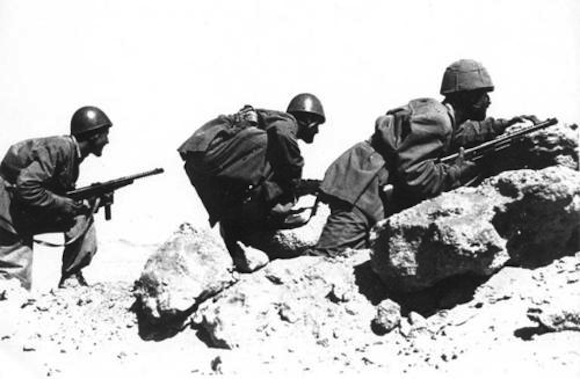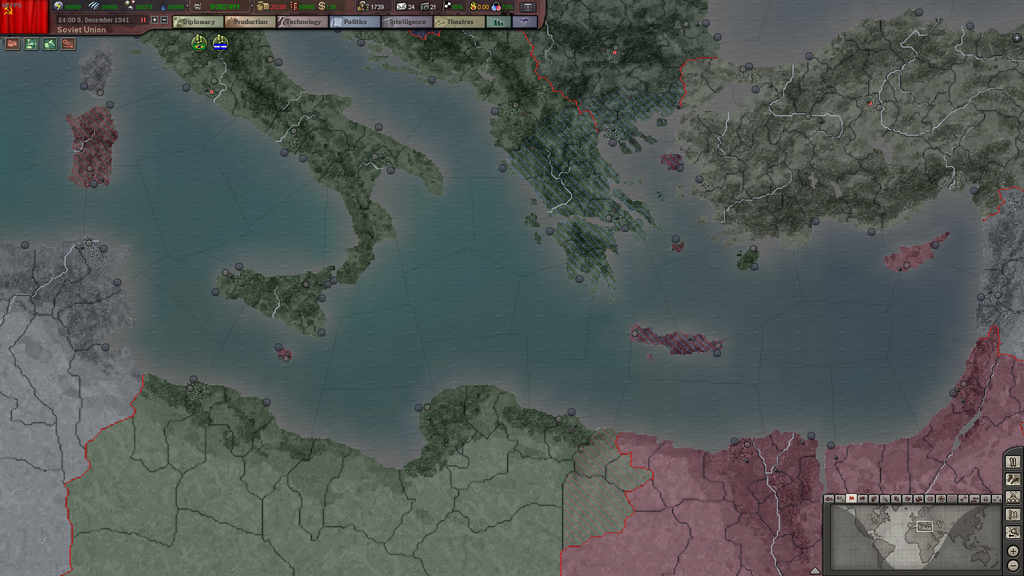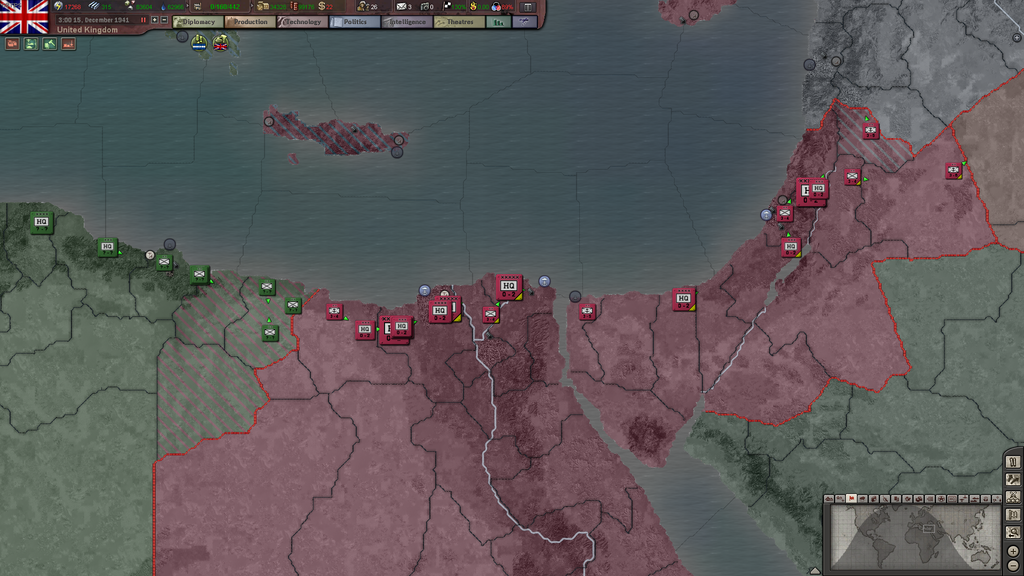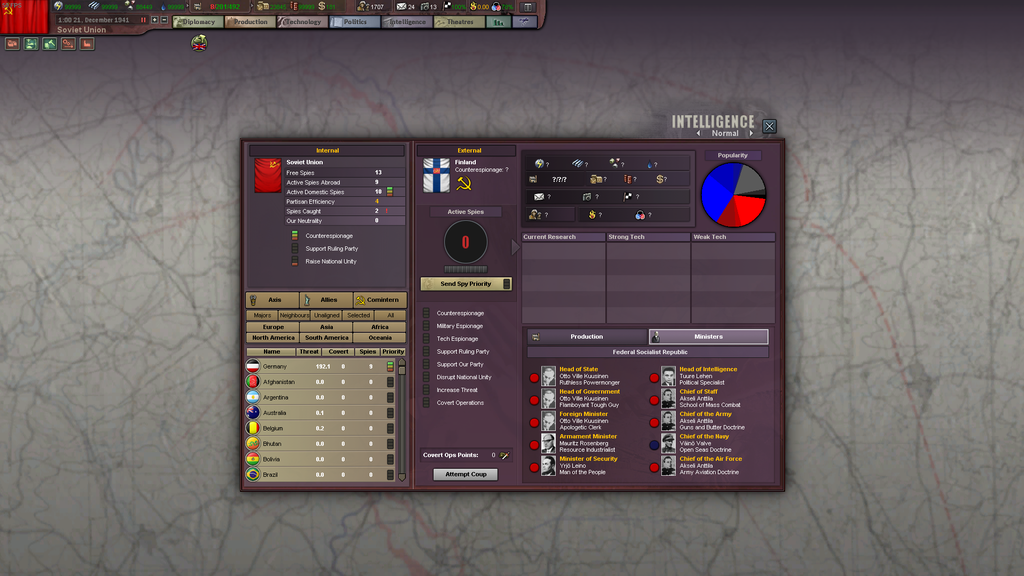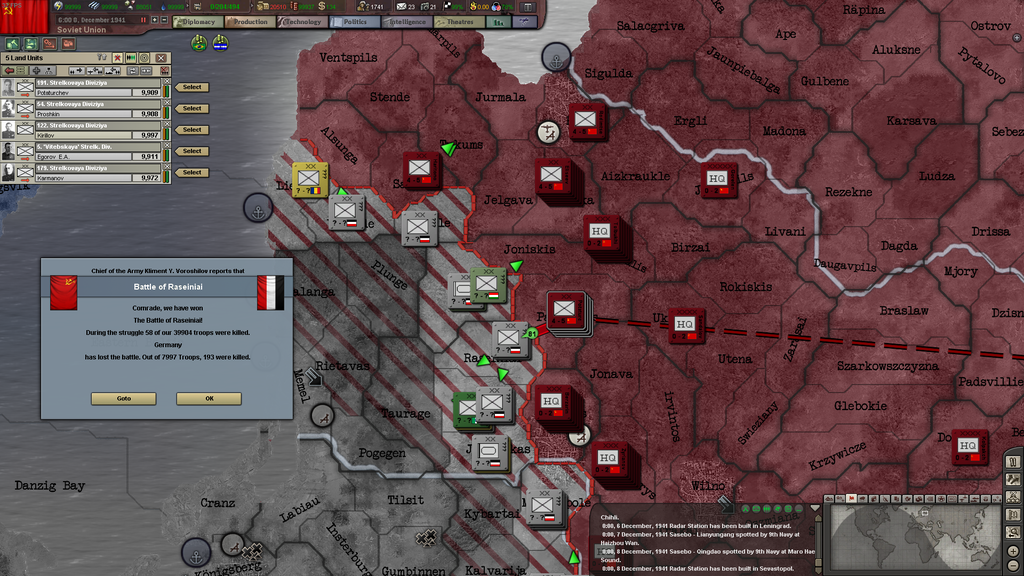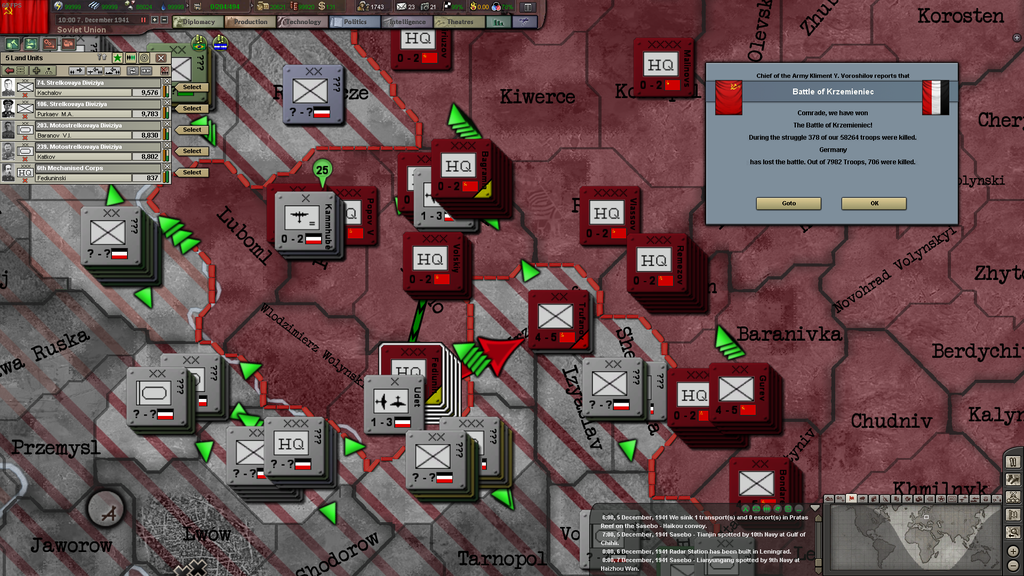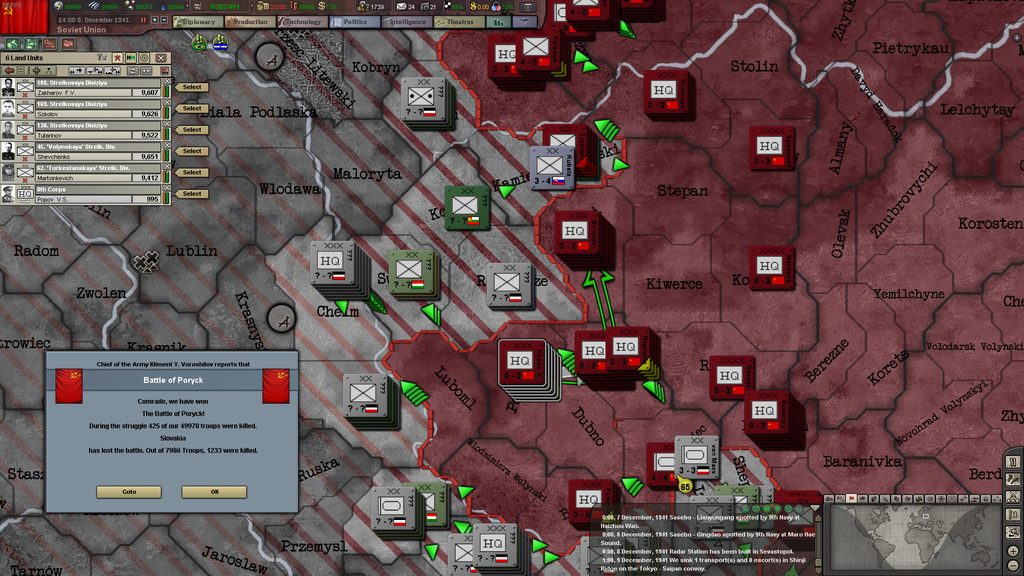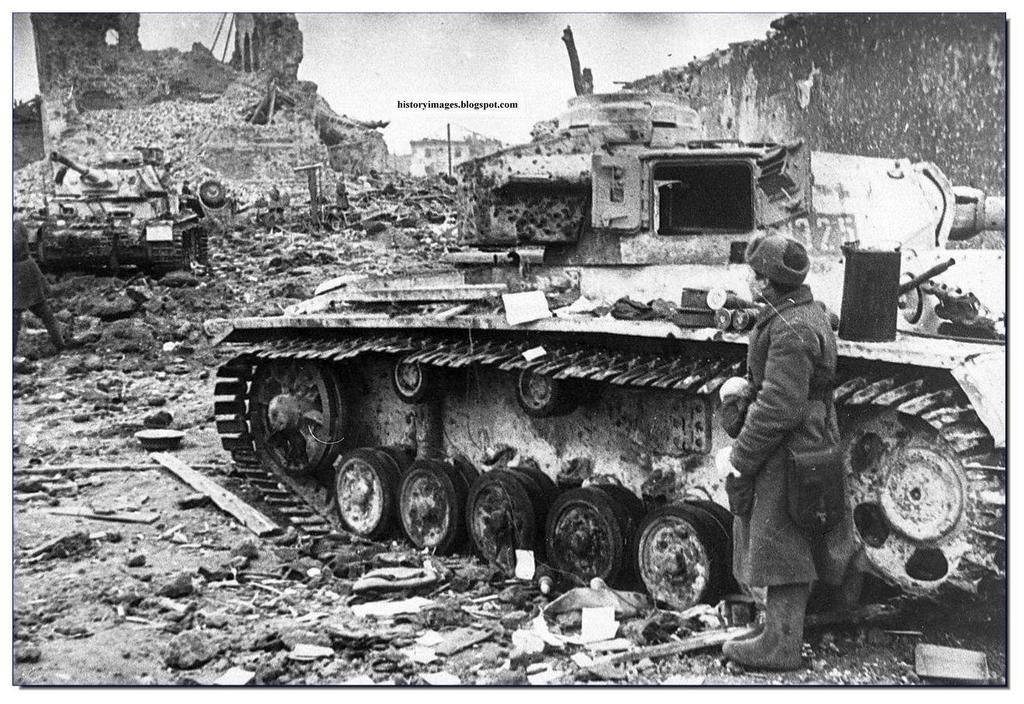Invincible and Legendary
The history of the Soviet Union during the Great Patriottic War
December 1941
Italian Folgore assault troops fighting at El Alamein, December 1941
Home Front and Foreign Affairs
In reaction to the recent successful defence of Dywin by Soviet IS-2 heavy tanks, high command requested another 2 divisions to be outfitted with these beasts of war. Backed by mechanised infantry, self-propelled guns and tank destroyers, STAVKA hope these heavy tank regiments will form the cornerstone of Red Army defences in the upcoming 1942 summer campaign.
The Japanese slowly pushed into the central Phillipines from the west after having taken Palawan. Midway and Eniwetok changed hands and Japanese troops have started incursions into the East Indies.
The British continued their operations in the eastern Mediterranean, taking several Greek islands and holding Sardinia. Fighting continues in Egypt with no end in sight, but it appears the British rule the seas and make life increasingly tough for the Italians.
With the entry of Vichy-France into the war the British Army of Egypt turned around to eliminate the threat tot heir rear posed by the troops in Syria. The Italians followed on their tail however and pushed deeper into Egypt. Still it seems unlikely the Axis will have enough troops to take the region, the local British army appears to outnumber both.
The Italians continued pushing forward and 6 days later they captured El Alamein after a short but fierce battle. Allied forces continued their retreat eastward as the relentless Italian advance marched towards the Suez Canal. At the same time the British troops continued to press into Vichy-controlled Syria, aiming to secure their rear before facing the Italian advance in strenght.
The Imperial Japanese Navy continued the Southward push with an amphibious invasion in Soerabaja, Java. They had also landed in the central part of the Phillipines and slowly advanced inland. Their troops had not reached the major islands yet, but without US reinforcements the Phillipine army would not hold out for long. In Burma and Malaya the Japanese and Siamese armies pushed forward slowly, but the Army of India and the defenders of Malaya held on stubbornly, preventing any real advance from happening.
Finnish Front
The Red Army had already overrun Helsinki and stood a mere 50 kilometers from Turku, the nation's second largest city, but with only 1 division. Other Soviet divisions slogged their way through the forests north of the Finnish capital where 2 Finnish divisions fought an effective delaying action. Several hundred soldiers on either side fell here, and the Soviet advance slowed to a crawl thanks to the darkness, poor weather and dogged resistance. The first week of December was mostly uneventful as the Finns retired towards Turku and Vaasa, their last major cities, and the Soviet infantry followed up. By the 9th the Soviets came to within 50 kilometers of both cities, having all but bypassed the last remnants of the Finnish army in the forests. These last defenders were being kept busy by the other Soviet divisions in a low-intensity war in the woods. A single German mountaineer division tried to assist the Finns in defending their country, but it was swept back north along with the Finnish troops when the Soviet infantry pressed deeper into the forests. Turku was secured by Soviet infantry on the 20th and the Red Banner Baltic Fleet sank one of the transport flotillas fleeing to city for Mariehamm island.
The fall of Turku was the final straw for the Finnish government. All her major cities were occupied, half her navy was sunk and the army dispersed. Some government officials were arrested and executed by Soviet security forces whilst others fled to Germany. In their place Stalin ordered a communist government led by Otto Kuusinen to be installed. This now also meant the entire Gulf of Finland was in Soviet hands, granting a boost to research and resources because of the much simplified trade routes in the eastern Baltic.
The Soviet 2. Infantry Corps, the troops that took central Finland and Vaasa, now turned north to reinforce the defences on the Norwegian border. The Germans still had several divisions in this sector and the area had to be secured to prevent them from attacking through Finland again.
Although Finland switched sides, fighting in the country was far from over. German infantry in Lapland attacked Soviet infantry just south of Petsamo and drove them back tot he city. At least a full German infantry corps had massed on the Norwegian side of the border, though it was as of yet unclear wether they could get across the harsh terrain in northern Finland to join the fighting.
Pockets of German resistance remained throughout the country and it would take time to mop them up. Still, with the Finns switching sides these units were cut off from supplies and reinforcements.
Baltic Front
After the major battles of Rietavas, Taurage, Palanga and Jurbarkas and the succesive breach formed in the Soviet lines in Latvia, the Red Army retired to the second defensive line in late November. This line was drawn up in the forests of central Latvia and ran from Riga to Kaunas, making use of the heavily forested region to improve the defences. Sporadic counterattacks were launched to delay the German divisions marching after them as the defenders dug in and prepared for another series of hard fights.
The Baltic Front saw little action for the majority of December. Italian infantry and German tanks assaulted Kaunas once again on December 23rd, leading to a 3-day street battle with the Red Guard Corps there. Using the narrow streets and prepared defences the guard slaughtered the attackers, with a total casualty toll exceeding 10:1. A simultanious Hungarian attack directly north of Kaunas ended even worse fort he attackers, seeing 1100 Hungarians killed for less than 100 Soviet defenders. Despite heavy German air support it was clear these defences would not be taken without heavy assault troops, something both the Italians and Hungarians lacked.
Polish Front
The Red Army struggled northeast of Lwow, trying to escape from the German attempt to surround the forces here. The 6th Mechanised corps' 2 armoured divisions turned around and attacked the German infantry occupying Krzemieniec, a city east of their positions. The ferocity and unexpected direction from which the attack on the German infantry came caught them by surprise and soon the armoured columns had formed a gap through which the infantry could retreat.
Just east of the infamous city of Wolkowysk, Soviet infantry make yet another stand in Rozana as the Germans attack it on the 4th. After 3 days of frontal attacks on the Russian trenches, all the attackers have to show for it is 1600 Russian and 2600 German dead and a town in ruins. The Soviet lines are being battered by heavy artillery and infantry assaults, but they do not break easily, even in this viciously contested sector.
The 1. Red Guard Corps had been relocated from the Baltic to the Polish Front and the troops were deployed in Janow, 50 kilometers east of Brest-Litovsk to bolster local defences. The Guard's posiitons soon came under attack by the Hungarian army, throwing 40.000 men into an attempt to drive the elite troops back. The Hungarian folly backfired immensly as their forces ran into concentrated artillery and small arms fire in the forests. The defenders also outnumbered the attackers, with regular infantry bolstering their ranks the Guard's positions were 70.000 men strong. Withering machinegun and artillery fire decimated the advancing Hungarians and only one of their divisions managed to engage in close combat. The attackers retreated after 2 days, leaving over 2700 dead behind. The Guard had suffered little over 400 casualties.
The Soviet army launched a counterattack on Wolkowysk once again in an attempt to sow chaos in the cluttered ranks of the 120.000 German and Italian soldiers in the city. It was hoped that with so many units, defence would be tough to organise and an attack would cause havoc. This succeeded to some extend when an 80.000 strong Soviet attack caused 1100 Axis casualties to 850 of their own, with a further 80 Soviet and 750 German dead in a German counterattack. The enemy was prevented from building up strenght in peace, but the situation in the central front became such that a tactical withdrawal was ordered.
The infantry in Rozana was exhausted in vicious fighting and fell back slowly so they could try to regroup before the next German attack hit their positions. Wether this would be possible was doubtful since the Germans kept up the pressure on the Soviet positions.
The German Tiger tanks advancing east from Lwow pushed ahead of their infantry and paid the price when the units entered the town of Shepetivka. 3 Soviet infantry corps with armour support attacked the division from the northwest, north and east and forced it back with a few hundred casualties on either side. For the moment the threat of a breakthrough had subsided once again. The German infantry following the heavy armour did secure the town once more and this time the Soviet troops could not dislodge them as easily.
Bulgarian and Slovakian infantry had taken up positions in Kamien Koszyrski, relieving the German troops that took the town earlier. They proved no match when a large Soviet infantry force launched a counterattack and retook the town on the 15th, killing 800 Bulgarians whilst losing only 200 men themselves.
Another major German attack on Rozana saw the attackers cut down by the hundreds with intense machinegun and artillery fire, though the defenders of the town were at the brink of collapse by now.
70 kilometers south of Kamien Koszyrski several German armoured and motorised divisions finally drove the last 2 Soviet divisions from the ruins of Luck. With the fall of Krzemieniec, on their left flank, the position had become untenable and these units were actually the last rearguard, sacrificed by High Command to give the others time to prepare new trenches. The rearguard broke on the 25th, but by this time the other troops were once again ready for battle further east, so the objective was achieved, though at a steep price.
Ukrainian Front
Though the arrival of large numbers of German divisions had led to the breaching of the Dniester river defences, the Ukranian Front continued to offer stiff resistance. On December 3rd, a German division attacking Pryvitne ran headlong into the machineguns of the Soviet 28th corps, suffering 1200 casualties to 400 Russians.
Further north in Dunaivtsi the Red Army had thrown 2 independent regiment s of IS-2 heavy tanks into the fray to support the 12th infantry corps in dealing with the relentless German tank assaults on their positions. The infantry was ordered to make a tactical withdrawal but was only able to do so once the appearance of heavy armour forced the German divisions back for the moment. But soon the Germans attacked again and after 3 days of fierce fighting it was decided to abandon the city. The infantry formations were exhausted and although the armoured units could still fight, they would not last long on their own so High Command decided to spare their strenght for later. 12th corps was evacuated from Dunaivtsi and the Germans took possesion of the ruins on Dcember 9th.
The freshly formed 3. Red Guard Corps was rushed forward to take up positions east of Dunaivtsi and relieve the exhausted troops. It grouped up with the independent 3rd Heavy Tank brigade and several infantry divisions and counterattacked the German light tank division occupying the town the next week. The overhelming fire had killed some 500 Germans and the panzer-division withdrew from the scene on the 15th. German forces on the flank in Proskurov suffered the same fate 2 days later, in spite of air support by the Hungarian airforce.
The next attack came from Tarnopol, seeing German infantry and heavy armour slam into Soviet combined infantry and armour entrenched in Polonne. At nightfall that day the Soviets withdrew, exhausted from battle. Reinforcements were en route however and would attempt to hold the area against the oncoming German panzers.
Italian and Bulgarian troops now relieved the German tank troops in Dunaivtsi and Bulgarians also attacked Kamien Koszyrski with light infantry once again. It is believed that at this point in the war the German generals used their allies as cannon fodder to weaken Soviet positions before sending their own divisions in. The Bulgarians were no match fort he entrenched Soviet infantry and heavy artillery decimated their troops during the attack. 500 Soviet and 2300 Italian and Bulgarian troops fell for no use other than keeping Soviet divisions occupied.
A ferocious tank battle raged 100 kilometers north in Krzemieniec where the exhausted Soviet 6th and 24th Mechanised corps clashed with a reinforced German Panzerkorps and Hungarian infantry. German local air superiority enabled their Stuka dive bombers to rain death down on the Soviets, destoying many tanks and trucks. Still the Axis divisions ran into a hail of gunfire when they advanced, losing hundreds of men before they even got to the Soviet positions. A confusing close-quaters tank battle ensued, whose outcome hang in the balance for hours. Eventually the Soviet defenders withdrew on orders from army commander general Vlassov. Soviet reinforcements had arrived and entrenched 20 kilometers further back, preparing to stop the enemy there. The delaying battle served its purpose, though it left the town of Krzemieniec devastated.
The Dniester defensive line continued to crumble slowly in the mean time with the SS “Totenkopf” division storming across the river into Tiraspol. German heavy tanks had already crossed the river on the flank and tried to reach the fighting, which would force the Soviet defenders to withdraw on the 19th after taking 1700 casualties.
A major Soviet infantry counterattack against the German Tiger tanks on the eastbank of the Dniester just before Christmas resulted in victory through sheer weight in numbers. Although the infantry antitank guns could not effectively deal with German heavy armour and air support was insufficient, a 12-1 advantage in numbers and a 3-pronged offensive was too much even for German heavy armour. 800 Soviet and 900 German casualties were suffered in the unequal battle before the heavy tanks withdrew beyond the river once more. Slowly it appeared the beachhead on the eastern riverbank could be reduced after all. Ananyiv was retaken on the 28th and a Hungarian-Bulgarian attack on Budei ended in a bloodbath on the attacking side.
Far Eastern Front
The Japanese offensive in the north continues to push across the river Shilka, pushing Soviet forces north into Siberia. The local airforce was ordered to evacuate from its last bases on the Pacific coast and head for airfields north of Manchuria on the 9th of December. From here the fighter aircraft can cover the ground forces when the Japanese offensive inevitably continues.
30th corps arrived that same day in order to reinforce the Soviet defences on the coast in the north. Further south a retreat was called. The 3rd and 4th Mountain Corps had held the southernmost sector of the line, closest to Vladiwostok. These troops were ordered to relocate north in order to assist the relief attempt underway.
A line was formed east of Kharbarovsk and this proved solid for the moment, a Japanese attack on Mukhen was repelled with ease. However the southern flank was still open and some 70 kilometers tot he south, Japanese marines advanced along the coast. Supply shortages began showing by now, but resistance was still very stiff and the Japanese could not easily dislodge the Soviet infantry.
As the troops in the south withdrew northward, the Manchurian army tried their luck in attacking the retreating columns. They found the Soviet artillery very active despite rumoured ammunition shortages, resulting in 300 Soviet and 1200 Manchurian dead, mostly due to shellfire.
In light of the Japanese breakthroughs and shattering Soviet lines in the Far East, 15 fresh divisions were formed into the 5th army and dispatched to the Far East.


